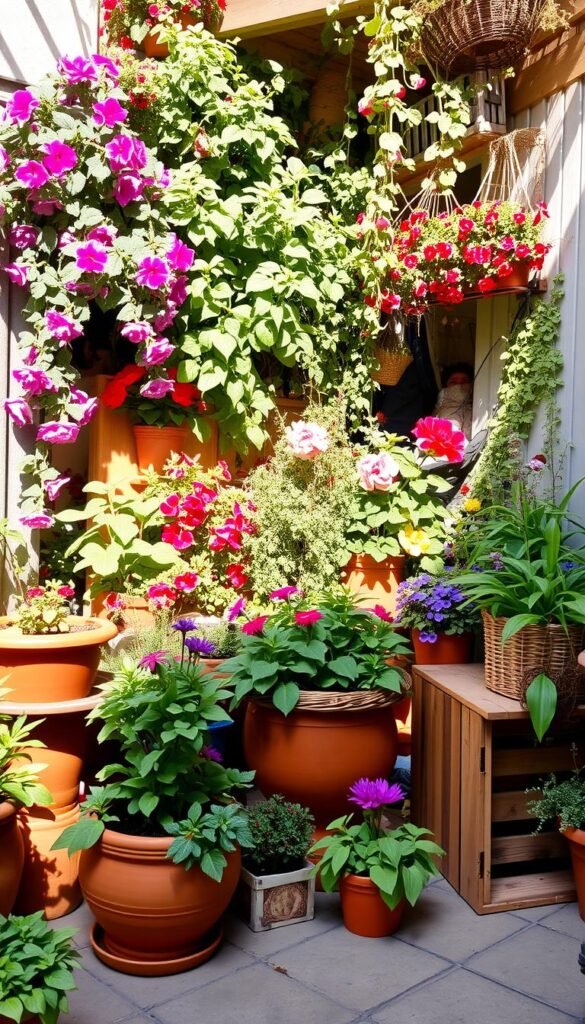Want to refresh your outdoor area without breaking the bank or spending hours on upkeep? Small-space gardening lets you turn even a tiny balcony or deck into a lively retreat. With just a few pots and the right plants, you can design a space that feels uniquely yours—no yard required.
This guide walks you through everything from choosing durable pots to pairing colors and textures for eye-catching displays. Whether you’re new to growing plants or looking to upgrade your setup, you’ll learn how to mix practicality with creativity. Best of all, you can change your arrangements as the seasons shift or your style evolves.
We’ll cover smart solutions for limited areas, like vertical planters and multi-level stands. You’ll also discover low-maintenance varieties that thrive in sun or shade. Ready to boost your home’s curb appeal? Let’s dig in!
Key Takeaways
- Transform small outdoor areas with strategic layouts and space-saving pots
- Swap plants seasonally to keep your display fresh year-round
- Combine different heights and textures for professional-looking arrangements
- Use lightweight containers for easy repositioning as sunlight changes
- Select drought-resistant varieties to simplify watering routines
Benefits of Container Gardening on Your Patio
Create a dynamic green space that grows with your needs. Potted arrangements let you experiment with bold hues and seasonal themes without permanent changes. You’ll love how one vibrant planter can become your outdoor focal point.
Instant Color and Style for Your Outdoors
Brighten dull corners with flowering plants like geraniums or petunias. Mix foliage textures—try spiky dracaena with trailing ivy. These combos work on tabletops or flanking doorways. Best part? Swap pansies for marigolds when spring turns to summer.
Space-Saving and Flexible Options
No room for raised beds? Use vertical gardening tricks. Hang ferns in baskets or stack herb pots on shelves. Lightweight resin containers let you chase sunlight across your deck. Even narrow balconies can host a mini garden of succulents or herbs.
Popular picks for shaded areas include coleus and begonias. Sunny spots? Lavender thrives with minimal watering. This adaptability makes planting ideal for renters or anyone craving changeable decor.
Understanding Container Types & Materials
Your planters do more than hold dirt—they shape your plants’ health and your space’s aesthetic. Let’s explore materials that balance function and style.
Terra Cotta, Ceramic, and Glazed Options
Terra cotta pots breathe like living organisms, letting roots access oxygen. But they dry out fast in summer heat. Ceramic versions retain moisture better but crack in freezing temps. Glazed containers? They’re the middle ground—less porous than clay but still offering airflow.
Pro tip: Use these for herbs or succulents that hate soggy roots. One gardener notes: “My rosemary thrives in terracotta but drowns in plastic.”
Plastic, Resin, Metal, and Wooden Containers
Modern resin pots mimic stone at half the weight—perfect for hanging displays. Metal planters add industrial flair but heat up quickly. Line them with coconut coir to protect roots. Wooden boxes? They insulate soil naturally but need drainage holes to avoid rot.
Consider these factors when choosing:
- Durability: Resin withstands harsh weather
- Weight: Plastic stays put on windy balconies
- Style: Painted metal complements modern decor
Match your material to your climate and plant needs. Desert-dwelling cacti love porous clay, while ferns flourish in moisture-trapping plastic. Your perfect container exists—you just need to know where to look.
Key Considerations for Container Size and Drainage
The success of your potted plants starts with two often-overlooked factors: their home’s size and breathability. Too small, and roots become cramped. Too large, and excess moisture lingers like an unwanted guest. Let’s explore how to strike the perfect balance.
Ensuring Proper Drainage to Prevent Root Rot
Drainage holes aren’t optional—they’re your first defense against soggy soil. One study found containers without holes increase root rot risk by 70%. For best results:
- Add pebbles or broken pottery at the base of pots
- Use potting mix with perlite for faster water flow
- Elevate planters with feet or stands
Size matters just as much. Herbs like basil thrive in 8-inch pots, while tomato plants need 18-inch homes. A simple trick? Match the container diameter to the plant’s mature width. This prevents moisture buildup while giving roots room to stretch.
Limited space? Go vertical. Stackable planters let you grow more in tight areas without sacrificing drainage. As one urban gardener puts it: “My balcony garden doubled once I switched to tiered boxes with built-in runoff trays.”
Remember: Overwatering kills more plants than neglect. Check soil dryness 2 inches deep before reaching for the hose. Your green friends will thank you with lush growth!
Selecting Easy-Care Flowers for Your Patio
Choosing the right blooms transforms your space into a colorful retreat with minimal effort. Focus on varieties that handle heat, drought, or low light while delivering vibrant hues. These picks work in both pots and multi-plant arrangements.
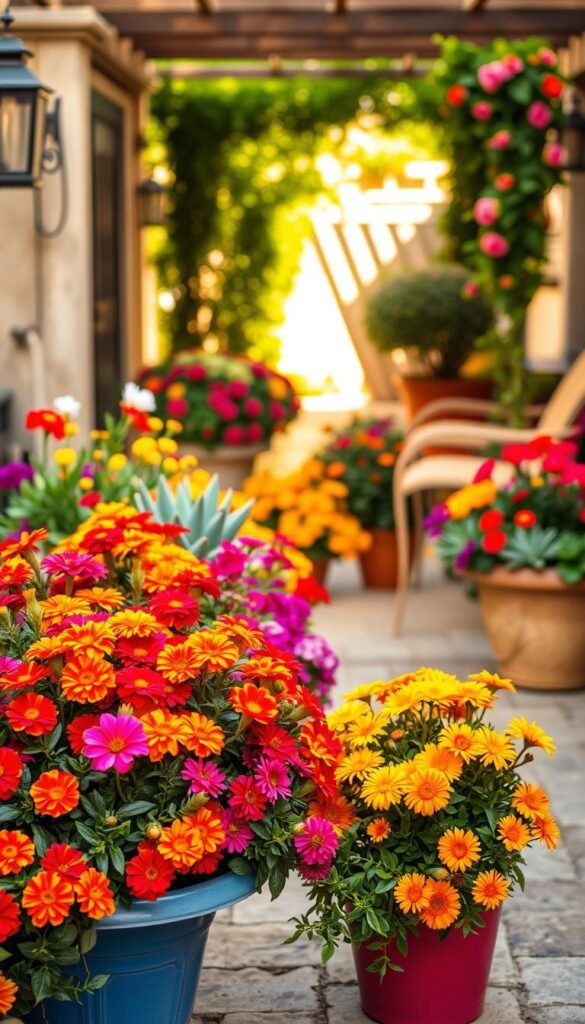
Sun-Loving Blooms for Bright Spaces
Petunias steal the show with their trumpet-shaped flowers that thrive in full sunlight. They need just 6 hours of daily sun and weekly watering. Geraniums offer bold reds and pinks while repelling mosquitoes—a bonus for summer evenings.
| Flower | Sun Needs | Water Frequency | Special Feature |
|---|---|---|---|
| Petunias | Full sun | Every 5 days | Self-cleaning blooms |
| Geraniums | 6+ hours | Weekly | Natural pest deterrent |
| Marigolds | Direct light | When dry | Edible petals |
Shade-Loving Flowers for Covered Areas
Impatiens brighten dim corners with jewel-toned blossoms that last until frost. Pair them with begonias for contrasting leaf shapes—their waxy foliage resists mildew in humid spots. Both thrive in morning light and afternoon shade.
Pro tip: “Mix coleus with flowering varieties—their purple-and-green leaves add drama even when blooms fade.”
Opt for perennials like heuchera to reduce replanting. Their silver-veined leaves return yearly, needing only occasional trimming. Combine textures and heights for arrangements that look polished with little care.
Incorporating Drought-Tolerant and Low-Maintenance Plants
Smart plant choices can turn your green space into a self-sufficient oasis. Drought-resistant varieties let you enjoy vibrant displays without daily watering—perfect for busy schedules or hot climates.
Exploring Resilient Plant Options
Succulents are rock stars of low-effort growing. Their fleshy leaves store water for weeks, thriving in sunny spots where other plants wilt. Pair them with lavender for aromatic purple spikes that bees adore. One gardener shares: “My stonecrop sedum survives 90°F summers with just monthly drinks—it’s practically bulletproof!”
These hardy options do more than save time. They reduce water use by up to 60% compared to thirsty annuals, making your container garden eco-friendly. Always match species to your region—agave excels in dry zones, while yucca handles humidity better.
For shaded areas, try snake plants or ZZ varieties. Their sword-like leaves add structure to arrangements, needing water only when soil completely dries. Rotate pots seasonally to prevent lopsided growth, and you’ll have a polished look with minimal fuss.
Remember: Resilient doesn’t mean boring. Red yucca sends up fiery blooms, while blue chalk sticks offer cool-toned foliage. Your space stays lively while you reclaim weekends from constant plant care.
Designing Your Patio Containers with Style
Elevate your green displays using professional design tricks that work in any setting. The secret? Combining height, texture, and movement for arrangements that look curated yet effortless.
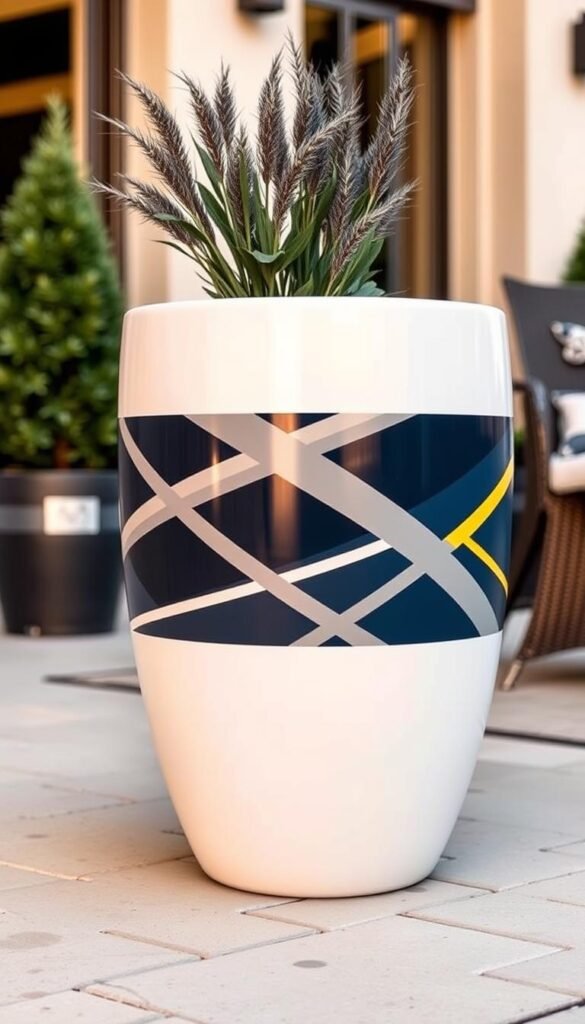
Mastering the Three-Part Formula
Think of your pot as a miniature stage. Start with a dramatic “thriller” – tall plants like cordyline or ornamental grasses grab attention. Surround them with bushy “fillers” such as begonias or coleus to add fullness. Finally, let “spillers” like ivy or creeping jenny cascade over the container’s edges.
This approach creates balance without symmetry. One gardener explains: “My 14-inch planter holds purple fountain grass (thriller), white vinca (filler), and golden sedum (spiller) – it’s like a living sculpture!”
Color Pairing and Texture Mixing
Contrast bold hues with softer tones for maximum impact. Pair lime-green sweet potato vine with deep purple petunias. Mix spiky dracaena leaves beside velvety lamb’s ear. These combinations add depth even in small spaces.
Remember:
- Repeat colors across multiple pots for cohesion
- Use variegated foliage as natural pattern-makers
- Limit palettes to 3-4 shades to avoid visual chaos
Your arrangements become focal points when you layer elements strategically. A well-designed container transforms bland corners into inviting nooks – proof that great style doesn’t require acres of land.
Creative Arrangements for Container Clustering
Grouping planters transforms flat spaces into lush landscapes. Clustered displays create depth, letting your eyes wander through layers of greenery and blooms. This approach works wonders on decks, balconies, or beside seating areas.
Using Plant Stands, Crates, and Tiered Shelving
Elevate your arrangements—literally. A three-tier metal stand holds herb pots at different levels, maximizing sunlight exposure. Wooden crates stacked sideways become instant display shelves for succulents or air plants. One urban grower notes: “My $5 flea market crate holds six mint varieties—it’s both functional and charming!”
Try these setups:
| Support | Best For | Style Tip |
|---|---|---|
| Plant stands | Creating height variations | Use matching colors for cohesion |
| Wooden crates | Rustic or industrial themes | Stain or paint to match decor |
| Tiered shelves | Small-space gardening | Add wheels for mobility |
Mix containers of varying sizes—pair a tall ceramic vase with squat terracotta pots. Let trailing plants like creeping thyme spill over edges, softening hard lines. Add texture with spiky yucca beside feathery ferns.
Pro tip: Cluster three arrangements using the “triangle rule”—place tall pieces at the back, mediums in the middle, and smalls up front. This creates museum-worthy vignettes that change with your planting whims.
Essential Container Gardening Tools and Supplies
The right toolkit turns your green dreams into reality while saving time and effort. Focus on items that simplify daily care and address common challenges like uneven watering or nutrient depletion. Let’s explore the gear that keeps your plants thriving with minimal fuss.

Watering Systems and Quality Soil Mixes
Drip irrigation kits deliver water directly to roots, cutting waste by up to 60% compared to sprinklers. Pair them with timer attachments for consistent hydration during vacations. For smaller setups, long-spout watering cans target soil without drenching leaves—key for preventing mildew.
Premium soil mixes make all the difference. Look for blends with perlite or vermiculite that retain moisture while draining excess. One urban gardener swears: “My basil doubled in size after switching to a mix with worm castings—it’s like plant superfood!”
Stock these essentials:
- Hand trowels with depth markers for perfect planting
- Pruners that fit comfortably in small spaces
- Moisture meters to prevent overwatering
Find durable pots at local nurseries or online retailers specializing in outdoor decor. Resin containers with UV protection last years without fading. A couple of self-watering planters can be game-changers for busy schedules—they store extra water in built-in reservoirs.
With these tools, maintaining your green oasis becomes a bit easier. You’ll spend less time troubleshooting and more time enjoying your blossoming retreat.
Tips for Proper Watering and Fertilizing
Keep your potted plants thriving with smart hydration and feeding strategies. Consistent routines prevent stress while encouraging lush growth—even in limited spaces. Let’s explore how to balance moisture and nutrients for vibrant displays.
Effective Watering Techniques for Healthy Roots
Water deeply until it flows from drainage holes—this ensures roots get moisture where they need it. Morning sessions reduce evaporation and help foliage dry before nightfall, cutting disease risks. Check soil daily in summer by sticking your finger 2 inches deep.
| Method | Best For | Frequency | Benefit |
|---|---|---|---|
| Soaker Hose | Large containers | Every 3 days | Even saturation |
| Watering Can | Precision | As needed | Control flow |
| Self-Watering Pots | Busy schedules | Weekly refill | Steady supply |
Establishing a Fertilizer Schedule
Feed plants every 2 weeks during growth phases with balanced 10-10-10 formulas. For perennials, switch to low-nitrogen mixes in late summer to prep for dormancy. One gardener shares: “I set phone reminders—every other Sunday at 8 AM keeps me on track.”
Pair granular slow-release pellets with liquid supplements for steady nutrition. In spring, refresh potting mix to replenish depleted minerals. Always water before applying fertilizers to protect delicate roots from chemical burns.
Remember: Healthy soil means happy plants. Choose mixes with compost or worm castings for natural nutrient boosts. With these tips, your green companions will reward you with non-stop color and vitality!
Pruning, Deadheading, and Maintenance Strategies
Keep your green displays thriving with smart maintenance routines. Regular pruning and deadheading aren’t just chores—they’re secret weapons for lush growth and endless blooms. A little effort here prevents bigger headaches later.
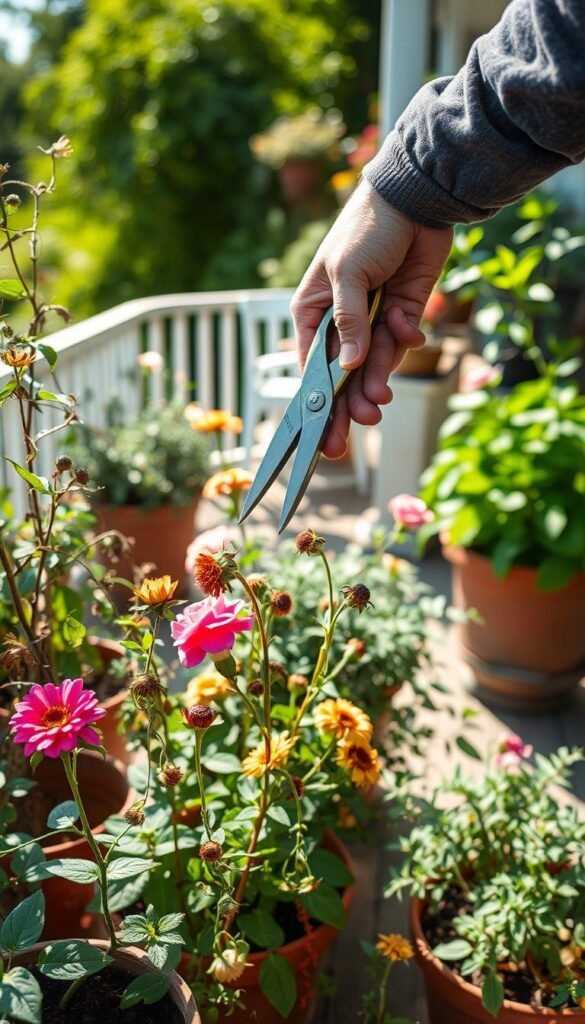
Timing Your Pruning and Deadheading Tasks
Snip spent flowers weekly to redirect energy into new buds. For most plants, early morning cuts heal fastest. As horticulturist Linda Chalker-Scott advises: “Remove dead material before noon—it reduces disease risk and speeds recovery.”
Shape shrubs after flowering peaks. Trim leggy stems by one-third using clean shears. This encourages bushier growth without stressing roots. Always cut above leaf nodes where new branches form.
Maintaining a Neat and Vibrant Container Garden
Clear yellow leaves promptly to stop mold spread. Check under leaves for pests during watering—a quick spray of soapy water handles most infestations. Improve airflow by spacing pots at least 6 inches apart.
Follow this simple routine:
- Deadhead spent blooms every 3-4 days
- Prune overgrown stems monthly
- Refresh topsoil in potting mix quarterly
Healthy soil means fewer problems. Add compost tea every 6 weeks to boost nutrients naturally. Your care efforts pay off in vibrant colors and strong, pest-resistant plants.
Patio Container Gardening: Practical Tips for Outdoor Living
Transform your outdoor space into a vibrant retreat with smart strategies that simplify care. By selecting durable materials and pairing complementary plants, you create displays that thrive with minimal time investment. Remember: success starts with matching container size to root systems and prioritizing drainage.
Think about your mix of textures and heights. A blend of tall grasses, mid-sized blooms, and trailing vines adds depth to small areas. As one gardener notes: “Grouping pots in odd numbers creates visual harmony—three or five always looks intentional.”
Timing matters. Water early to reduce evaporation, and fertilize every two weeks during growth spurts. Rotate sun-loving varieties seasonally—swap pansies for zinnias when temperatures rise. This keeps your arrangements fresh without constant replanting.
Review earlier sections for specifics on soil blends, vertical solutions, and pest control. With thoughtful planning, even compact spaces become lush extensions of your home. Now’s the perfect moment to start—your future oasis awaits!
Container Gardening for Herbs and Vegetables
Turn your cooking ingredients into living decor with edible arrangements that thrive in tight spaces. Growing herbs and veggies in pots lets you control soil quality and moisture levels precisely—key factors for flavorful harvests. Urban dwellers report 80% success rates with these compact setups compared to traditional plots.
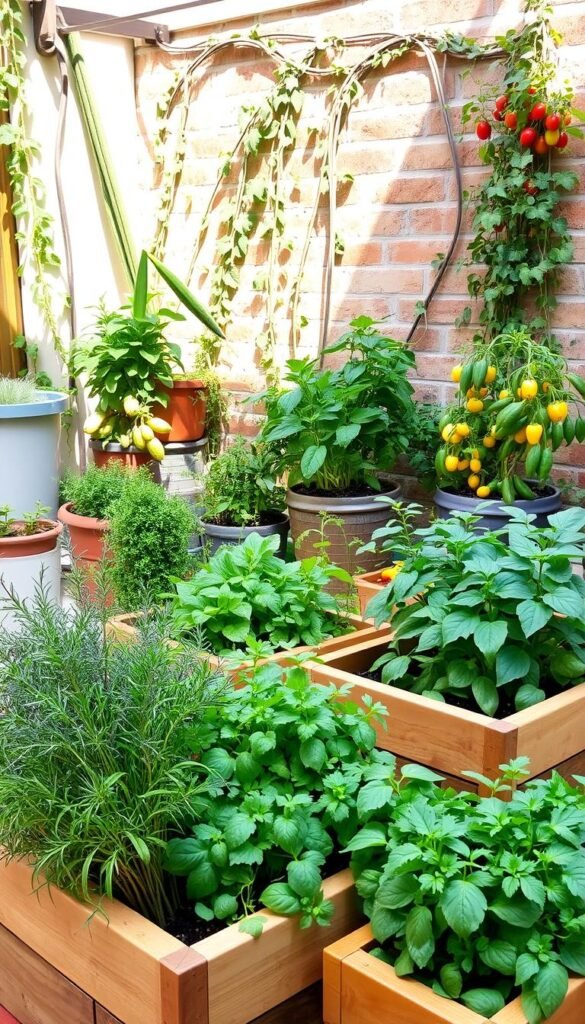
Herb Container Gardening Ideas
Group herbs by cuisine for easy access while cooking. An Italian trio might feature basil, oregano, and thyme in separate but adjacent plants. For vertical interest, try stacking mint varieties in a tiered planter. One gardener shares: “My window box of chives, parsley, and cilantro stays productive all summer with weekly trims.”
| Herb Type | Container Size | Sun Needs | Harvest Tips |
|---|---|---|---|
| Rosemary | 12″ deep | 6+ hours | Snip stems weekly |
| Basil | 8″ wide | Morning light | Pinch flower buds |
| Mint | 10″ pot | Partial shade | Cut 1/3 growth |
A Guide to Vegetable Container Plantings
Start with compact varieties bred for small spaces. Cherry tomatoes and dwarf peppers perform well in 5-gallon buckets. Follow these steps for success:
- Choose containers twice as wide as mature roots
- Mix potting soil with compost (3:1 ratio)
- Water when top inch feels dry
- Rotate pots weekly for even sun exposure
Leafy greens like kale adapt well to shallow boxes—just monitor moisture closely. A moisture meter helps prevent over-watering. With proper care, your edible garden can produce fresh meals for years, proving good things truly come in small packages.
Creating a Patio Garden That Reflects Your Style
Your outdoor space becomes a canvas when you infuse it with personal flair. Think beyond basic arrangements—your planters can mirror your taste just like indoor decor. A pop of color here or an unexpected texture there turns ordinary pots into signature pieces.
Personalizing Your Planter Design
Start by choosing vessels that spark joy. Love mid-century modern? Try geometric concrete planters. Prefer cottage charm? Repurpose vintage tea tins. One gardener transformed old boots into quirky herb homes: “They’re conversation starters and keep my thyme thriving!”
Mix materials for visual intrigue. Pair sleek metal with rough-hewn wood, or glossy ceramic with woven baskets. Combine tall cylindrical pots with squat bowls in coordinating hues. This creates rhythm without matchy-matchy uniformity.
Add character through accents:
- Paint patterns using weather-resistant stencils
- Drape fairy lights around trailing ivy
- Place miniature garden statues among succulents
| Style | Planter Choice | Plant Pairing |
|---|---|---|
| Bohemian | Macramé hangers | Spider plants + pothos |
| Industrial | Galvanized tubs | Snake plants + aloe |
| Coastal | Driftwood boxes | Blue chalk sticks + sedum |
Refresh your setup seasonally with a couple of new pieces. Swap summer’s terracotta for autumn’s copper tones. Even small changes—like adding mosaic tiles to plain pots—make a big impact. Remember: great design grows from what makes you smile.
Overcoming Common Patio Gardening Challenges
Even the most vibrant green spaces face hurdles—but smart fixes keep your oasis thriving. Limited room, tricky watering needs, and uninvited critters can test any plant lover. Let’s tackle these head-on with solutions that blend function and flair.
Smart Solutions for Tight Quarters and Thirsty Roots
Vertical planters reclaim wall space for herbs or strawberries. Try stacking pots on ladder shelves—they add height without crowding walkways. For moisture control, self-watering containers with reservoirs prevent drought stress during heatwaves.
Compact perennials like dwarf lavender work wonders in small areas. Pair them with seasonal annuals for year-round interest. Check soil daily using your finger—if the top inch feels dry, it’s drink time. A gardener friend swears: “My moisture meter cut my plant losses by half last summer!”
| Challenge | Quick Fix | Long-Term Solution |
|---|---|---|
| Limited space | Hanging baskets | Tiered plant stands |
| Overwatering | Add perlite to soil | Use terracotta pots |
| Shallow roots | Mulch surface | Deep watering technique |
Keeping Greens Healthy and Pest-Free
Inspect leaves weekly for bugs or discoloration. A mix of water and dish soap handles most aphid invasions. For stubborn cases, neem oil sprays work naturally without harsh chemicals.
Prevent issues before they start:
- Rotate plantings yearly to disrupt pest cycles
- Space pots for better air circulation
- Remove dead leaves promptly
Remember—every challenge is a chance to get creative. One urban grower turned an old shoe organizer into a vertical herb garden. With a bit of ingenuity, your green haven will flourish despite the odds!
Seasonal Patio Gardening Tips and Planting Ideas
Keep your green space lively through every season with smart timing and plant swaps. Rotate varieties to match weather patterns while maintaining visual appeal. This approach ensures your arrangements stay healthy and eye-catching year-round.
Spring Refresh and Summer Maintenance
Early spring is prime time for cool-weather favorites like pansies and snapdragons. These plants thrive when nights stay above 40°F. As temperatures rise, transition to heat-lovers like lantana and zinnias. One gardener shares: “I start my summer geraniums indoors six weeks before our last frost date—they hit the ground blooming!”
Adjust your soil mix for summer by adding water-retaining crystals. Mulch surfaces with gravel to reduce evaporation. Water deeply before 10 AM to combat midday heat stress.
| Season | Key Tasks | Top Plant Picks |
|---|---|---|
| Spring | Fertilize bulbs Divide perennials |
Primroses Daffodils |
| Summer | Deadhead weekly Check for pests |
Petunias Portulaca |
Fall Transition and Winter Prep
Swap fading annuals for mums and ornamental kale when nights cool. Protect roots by wrapping garden pots in burlap before first frost. Reduce watering frequency as growth slows—overly damp soil invites rot during dormancy.
Clean tools and store unused mix in sealed containers. Plan next year’s layout using lessons from this season. A simple sketch helps track what thrived where. With these steps, you’ll save time when spring planting begins anew.
Conclusion
Your journey to a lush outdoor retreat starts with simple steps and creative vision. You’ve discovered how strategic layouts and seasonal swaps keep displays fresh, while proper drainage and plant pairing ensure healthy growth. Whether working with herbs or flowers, success lies in matching greenery to your light conditions and lifestyle.
Consistent care transforms basic arrangements into living art. Water when soil dries, rotate sun-lovers weekly, and refresh soil annually. These simple tips help even novice growers maintain vibrant displays. Remember: your garden evolves with you—don’t fear moving pots or trying bold color combos.
Now’s the time to start arranging your pots with confidence. Mix heights and textures using the thriller-filler-spiller approach. Let trailing vines soften edges while upright grasses add structure. Your efforts will bloom into a personalized oasis that mirrors your taste.
Revisit earlier sections for specifics on soil mixes or vertical solutions. With each season, you’ll grow more adept at balancing beauty and practicality. Your green sanctuary awaits—one resilient plant at a time.

